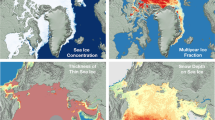Abstract
This study presents the monthly climatology and variability of the historical soviet snow depth data. This data set was developed under the bilateral data exchange agreement between United States of America and the former Union of Soviet Socialist Republics. The original data is for 284 stations for periods varying from 1881 upto 1985. The seasonal cycle of the mean snow depth has been presented both as spatial maps and as averages over key locations. The deepest snow (=80 cms/day) areas are found over Siberia (in Particular over 80′–100 ′E, 55′–70 ′N) during March. Over the course of the annual cycle average snow depth over this region changes dramatically from about 10 cms in October to about 80 cms in March. The variability is presented in the form of spatial maps of standard deviation. To investigate the interaction of snow depth with Indian monsoon rainfall (IMR), lag and lead correlation coefficients are computed. Results reveal that the winter-time snow depth over western Eurasia surrounding Moscow (eastern Eurasia in central Siberia) shows significant negative (positive) relationship with subsequent IMR. Following the monsoon the signs of relationship reverse over both the regions. This correlation structure is indicative of a midlatitude longwave pattern with an anomalous ridge (trough) over Asia during the winter prior to a strong (weak) monsoon. As the time progresses from winter to spring, the coherent areas of significant relationship show southeastward propagation. Empirical orthogonal function analysis of the snow depth reveal that the first mode describes a dipole-type structure with one centre around Moscow and the other over central Siberia, depicting similar pattern as the spatial correlation structure. The decadal-scale IMR variations seem to be more associated with the Northern Hemisphere midlatitude snow depth variations rather than with the tropical ENSO (El Nino Southern Oscillation) variability.
Similar content being viewed by others
Author information
Authors and Affiliations
Additional information
Received: 16 March 1998 / Accepted: 24 December 1998
Rights and permissions
About this article
Cite this article
Kripalani, R., Kulkarni, A. Climatology and variability of historical Soviet snow depth data: some new perspectives in snow – Indian monsoon teleconnections. Climate Dynamics 15, 475–489 (1999). https://doi.org/10.1007/s003820050294
Issue Date:
DOI: https://doi.org/10.1007/s003820050294




